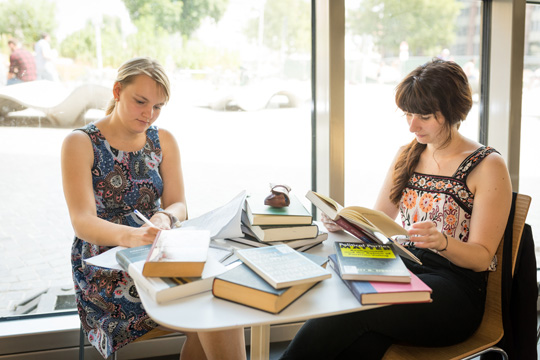Less hocus-pocus, more structure
Freiburg, Oct 01, 2018
Even back in school we tried to find the best way of learning. But strategies and patterns which once worked in the classroom don’t always work with university material, says Dr. Alexander Eitel from Educational and Developmental Psychology at the University of Freiburg. Students need to know how to increase their own motivation with the strategies they develop themselves - thereby taking in knowledge more effectively and consistently. Eitel spoke with Pauline Grünwald about how they can do this, and how teaching staff can influence students’ learning success.
 Anecdotes and abracadabra - Any attempt to spruce up a theoretical topic with seductive details does not usually work. Photo: Lainen/Fotolia
Anecdotes and abracadabra - Any attempt to spruce up a theoretical topic with seductive details does not usually work. Photo: Lainen/Fotolia
Dr. Eitel, you have investigated the notion of “seductive details” in teaching and learning contexts. How do you define the term?
Alexander Eitel: “Seductive details” are bits of information which have no relevance for the real learning goal. They may be presented as decorative images, text blocks, or little anecdotes, and they provide additional content which is interesting for everyday life. Supposing I want to explain isotopes in Chemistry. I could talk about an episode of The Simpsons“ in which Homer Simpson calls himself a fan of the “Albuquerque Isotopes” – a name which a baseball team really did adopt two years after the program was aired.It’s no surprise that stories like that shift the focus away from what’s really relevant. That means there is a danger that they will stick in students’ minds - instead of the main message of the lesson.
Are there contexts in which seductive details are helpful to learning?
Not directly. But the manner in which seductive details are presented is interesting for teaching contexts. They are often related to particular events in politics and society. It would make sense to apply this current relevance to the real content of the lecture or seminar. That makes a connection to the students’ prior knowledge and experience, and they will be able to process and store the information better.
Getting and keeping the attention of students is not easy.
There’s a good saying about that: “You can’t make something interesting if it isn’t interesting.” Any attempt to sex up a theoretical topic with seductive details does not usually work. On the contrary - the material which follows a funny story seems all the drier. So anyone who can’t pass up those kinds of cognitive appetizers in his/her teaching altogether would be well advised to use them sparingly and to make very clear that’s what they are. It is also a good idea to put such additions in between completed units, so as to avoid breaks in coherency.
 “You should do serious preparation for practice exams because there is often a huge leap in learning after doing one.” Photo: Ingeborg F. Lehmann
“You should do serious preparation for practice exams because there is often a huge leap in learning after doing one.” Photo: Ingeborg F. Lehmann
How can images help students to remember the material better?
Reading a text places you in danger of literally getting the wrong picture. If the text is talking about a triangle, every reader has a different image in mind. Some see a red equilateral shape. Others thing of the pyramids in Egypt. In order to give all readers of a text the same understanding, it is good to make the work more precise by providing pictures. That way, you avoid interpretation-based discrepancies in the collective understanding and avoid burdening the students with unnecessary work. To make diagrams as easy as possible to understand, you can add explanatory captions, arrows, or direct references from the text.
What should teachers pay attention to when planning a lesson?
First, teachers should ask themselves - What goal do I have when I use which method? When preparing scripts in particular, there are a number of things to watch. Pictures and diagrams must always fulfil a cognitive function. That means they should help organize the text and make the text easier to understand. Mind maps and diagrams are good examples of this. Online learning methods are used a lot. Teaching staff should familiarize themselves with the technical possibilities in advance, so as to use the full potential of the method. It’s the same with every teaching and learning technique - if it is not used correctly, it won’t work.
So, should learning materials and tests be as simple as possible?
If you design the learning material for students to be as simple as possible, they can confidently recall what they have learned soon afterwards in tests. With simple design you can improve the processes responsible for short-term memory. But it is the exact opposite for the mechanisms which ensure long-term knowledge growth for the student. Here it is sometimes even helpful if content is presented as more difficult and students initially do worse in tests. This enables one to identify the topics one should look at more closely.
 If you make a date with someone to study together, it becomes more likely that you will actually do it. Photo: András Wekler
If you make a date with someone to study together, it becomes more likely that you will actually do it. Photo: András Wekler
What can students do to organize their learning more effectively?
It can be helpful to make dates with yourself to study. For this you can run through the question words: When and how shall I learn what where with whom? These agreements raise the likelihood of actually getting down to study. It is also effective to form a study group. Furthermore you can prepare your learning location to function as a call to sit down and start work. For example you can switch on your laptop, and put a notepad, pens and other things you need out ready. In combination, that study date and the preparations made work as a catalyst for the desired behavior.
Does that mean that planning can help you remember content better?
At the very least, it prevents binge-learning sessions, in which the knowledge is not stored long-term. Basically, everyone has to find a learning strategy to suit the type of person they are. In our department we have developed an online tool called ELIS to support students. Also, studies have shown that just repeating a text is less effective. Reorganizing the information, presenting it graphically or thinking of questions to ask yourself are better ways to contribute to long-term knowledge growth. Exam situations also help to store content for the long term. The help you to not only learn more effectively, you also experience the test situation and can cut down your fears and nervousness. You also discover which content you were unable to recall and have the chance to focus on that more closely. One good tip: You should do serious preparation for practice exams because there is often a huge leap in learning after doing one.
Alexander Eitel’s studies on multimedia learning and the effect of practise exams

